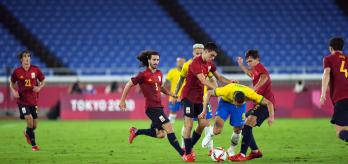The increasing importance of a rest defence
Over the last 15 years, the manner in which football teams have transitioned from defence to attack has become increasingly devastating. In a matter of mere seconds, a side that is attacking the opposition’s box can quite easily lose possession and immediately find themselves on the back foot in their defensive third. Due to this constant threat during transition, being conscious of one’s defensive structure when in possession has acquired the same significance as creating goalscoring opportunities. In the modern game, the defensive structure a team adopts when in control of the ball – commonly known as a rest defence – has emerged as a vital step to achieving defensive stability and establishing a platform on which to apply an effective counter-press.
Dictating the play out of possession
Spain are widely renowned for applying a football philosophy in which retaining possession plays a key role in the team’s quest to dominate games. In recent years, La Roja have employed this blueprint to dominate matches to such an extent that implementing a rest defence may actually be considered to be unnecessary. However, when the silver medallists were in possession at the Olympic tournament, they clearly adopted a rest defence structure. By doing so, the Spaniards displayed a willingness to try to dictate games when out of possession, a strategy that represents a departure from their traditional approach.
Today, you can go from attacking in the final third to defending your own box in an instant. Teams that look to dominate possession must be aware of the immediate threats modern transitioning and counter-attacks can cause them.
Spain's rest defence structure
With Spain’s starting left-back Marc Cucurella (number 3) pushing up the pitch to join the attack, right-back Óscar Gil (18) came inside to form a box and create the rest defence structure alongside central midfielder Martín Zubimendi (6) and the centre-back pairing. The box’s effectiveness as a rest defence structure was visible in Spain’s second-round meeting with Australia. When Spain lost possession, their rest defence ensured that they were well prepared to deal with counter-attacks and provided a solid platform on which to counter-press, thereby preventing Australia from posing any sort of threat during transitions. In the gold-medal showpiece, this same structure once again helped Spain to largely nullify the considerable menace offered by Brazil on transitions.
Spacing and structure are key
Meanwhile, Mexico at times adopted a unique rest defence that suited their rapid transition style. The generous spacing between the players comprising the rest defence enabled the bronze medallists to transition quickly up the pitch after regaining possession. The Mexicans struck the right balance in terms of the spacing between players, which if too great would have resulted in them being unable to reach opposing players who turned the ball over. Despite their attack-heavy approach, the Tricolor always sought to ensure that they had a rest defence in place that included an intact back four that was supported by one, or sometimes two, central midfielders. This offered the Mexicans the necessary structure to remain defensively rigid when they relinquished possession, whilst ensuring that their approach was not too conservative and ended up inhibiting their devastating counter-attack once they won the ball back.
The tactical value of experience
One commonly discussed topic within the game relates to experienced players and the role they have to play in boosting the morale of younger team-mates and offering advice during key moments. However, in the Brazil ranks, right-back Dani Alves’s (13) footballing wisdom had clear tactical value in the gold medallists’ rest defence. Depending on the number of opposing strikers, Alves would either operate as part of a three-man backline (in Brazil’s 3-2 rest defence structure) or slot in as part of the midfield three (in their 2-3 rest defence). Brazil’s platform for counter-pressing and ball circulation was heavily dependent on Alves’s ability to adopt the right position within the defensive set-up.









